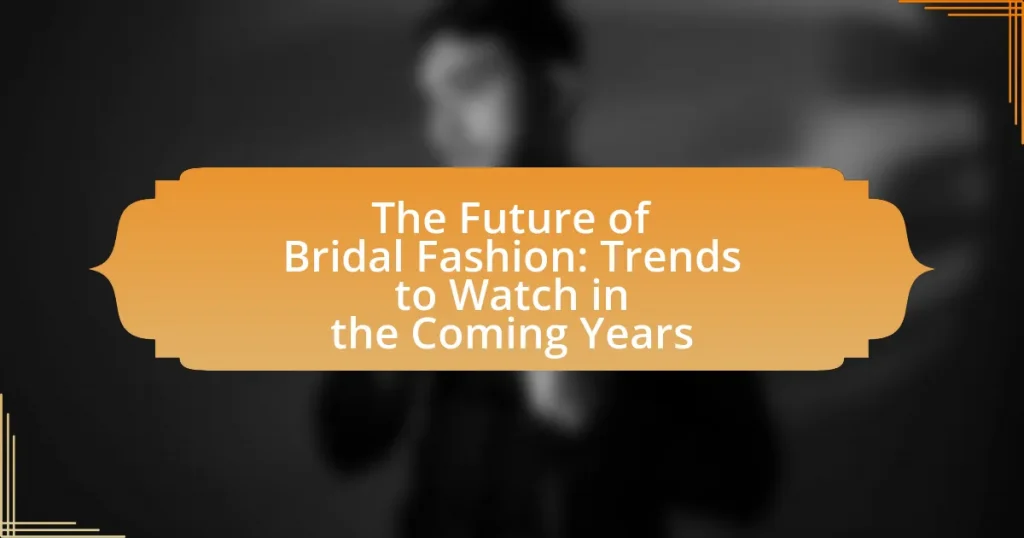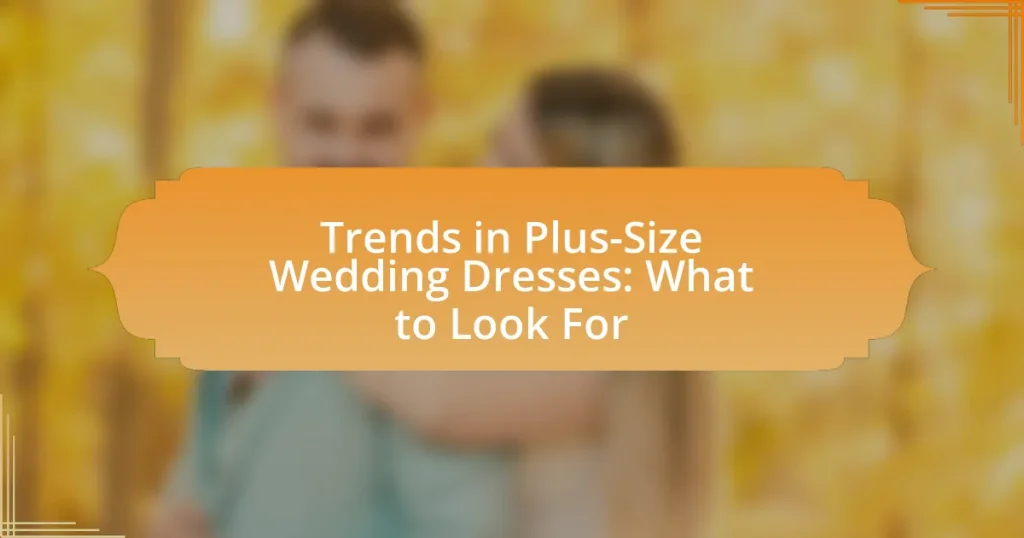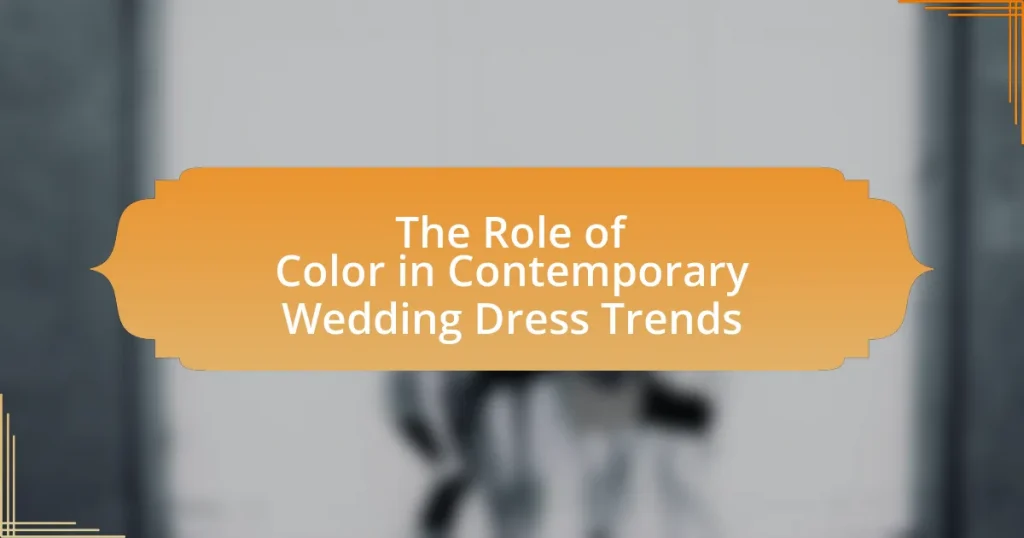The article focuses on the future of bridal fashion, highlighting emerging trends such as sustainability, personalization, and the integration of technology. It discusses how cultural influences are shaping bridal designs, with an emphasis on diverse styles and materials from various traditions. Additionally, the article examines the role of sustainability in bridal wear, detailing how designers are adopting eco-friendly practices and materials. Key styles, silhouettes, color palettes, and essential accessories for modern brides are also explored, along with tips for brides to navigate their choices while balancing personal style and current trends. Overall, the article provides a comprehensive overview of the evolving landscape of bridal fashion.
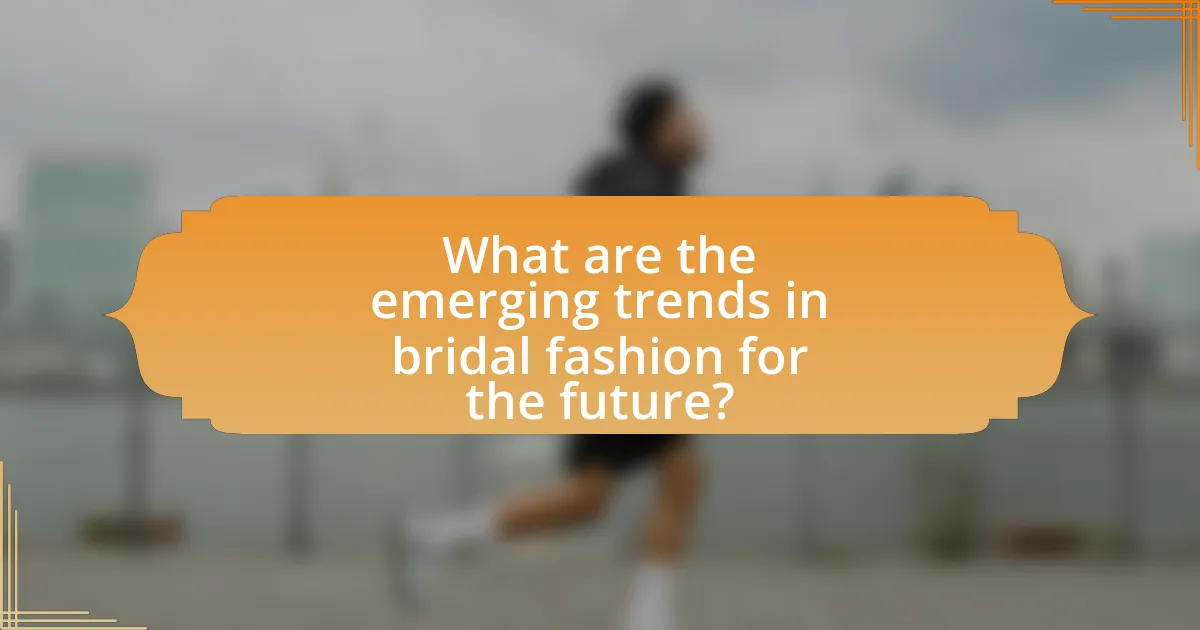
What are the emerging trends in bridal fashion for the future?
Emerging trends in bridal fashion for the future include a shift towards sustainability, personalization, and the incorporation of technology. Sustainability is becoming a priority, with designers increasingly using eco-friendly materials and ethical production practices, reflecting a growing consumer demand for environmentally responsible choices. Personalization is also on the rise, as brides seek unique designs that reflect their individual styles, often opting for custom gowns or mix-and-match separates. Additionally, technology is influencing bridal fashion through innovations such as virtual fittings and augmented reality experiences, allowing brides to visualize their looks before making a purchase. These trends are supported by industry reports indicating a significant increase in demand for sustainable and personalized bridal options, as well as advancements in fashion technology.
How are cultural influences shaping bridal fashion trends?
Cultural influences are significantly shaping bridal fashion trends by introducing diverse styles, fabrics, and traditions from various cultures into mainstream bridal wear. For instance, the incorporation of elements such as intricate embroidery and vibrant colors from South Asian weddings has gained popularity in Western bridal fashion, reflecting a growing appreciation for multiculturalism. Additionally, the rise of global connectivity through social media platforms allows brides to draw inspiration from international trends, leading to a fusion of styles that blend traditional and contemporary aesthetics. This shift is evidenced by the increasing presence of non-white wedding dresses and the adoption of cultural symbols, such as henna designs, in bridal attire, showcasing a broader acceptance of varied cultural expressions in the wedding industry.
What specific cultural elements are being incorporated into modern bridal designs?
Modern bridal designs are increasingly incorporating specific cultural elements such as traditional fabrics, motifs, and ceremonial practices from diverse cultures. For instance, Indian bridal wear often features intricate embroidery and vibrant colors, while Japanese designs may include kimono-inspired silhouettes and silk materials. Additionally, African influences are seen in the use of bold patterns and headwraps, reflecting cultural heritage. These elements not only enhance the aesthetic appeal of bridal gowns but also celebrate the rich diversity of cultural traditions in contemporary weddings.
How do these cultural influences affect the choice of materials and styles?
Cultural influences significantly shape the choice of materials and styles in bridal fashion by dictating aesthetic preferences and traditional practices. For instance, in many Western cultures, white silk is favored for its association with purity, while in Indian culture, vibrant colors and rich fabrics like silk and brocade are preferred, reflecting cultural heritage and symbolism. Additionally, the rise of global connectivity has led to a blending of styles, where designers incorporate elements from various cultures, such as lace from European traditions combined with intricate embroidery from Asian influences. This cross-cultural exchange not only diversifies material choices but also enriches the overall design aesthetic, catering to a broader audience and reflecting contemporary values of inclusivity and diversity in bridal fashion.
What role does sustainability play in the future of bridal fashion?
Sustainability plays a crucial role in the future of bridal fashion by driving the industry towards eco-friendly practices and materials. As consumer awareness of environmental issues increases, bridal designers are adopting sustainable fabrics, such as organic cotton and recycled materials, to reduce their carbon footprint. According to a 2021 report by the Ethical Fashion Initiative, the global sustainable fashion market is projected to reach $8.25 billion by 2023, indicating a significant shift in consumer preferences towards environmentally responsible choices. This trend not only reflects a growing demand for ethical production but also encourages brands to innovate in their design processes, ensuring that sustainability becomes a standard rather than an exception in bridal fashion.
How are designers adopting sustainable practices in bridal wear?
Designers are adopting sustainable practices in bridal wear by utilizing eco-friendly materials, implementing ethical production methods, and promoting circular fashion. For instance, many designers are now sourcing organic fabrics, such as organic cotton and hemp, which reduce environmental impact compared to conventional materials. Additionally, brands are increasingly focusing on local production to minimize carbon footprints and ensure fair labor practices. A notable example is the use of upcycled materials, where designers transform vintage garments into new bridal pieces, thereby reducing waste. This shift towards sustainability is supported by consumer demand for environmentally responsible fashion, with a 2021 survey indicating that 66% of global consumers are willing to pay more for sustainable brands.
What are the benefits of choosing sustainable bridal fashion for brides?
Choosing sustainable bridal fashion offers brides numerous benefits, including environmental impact reduction, ethical production, and unique design options. Sustainable bridal fashion minimizes waste and carbon footprint by utilizing eco-friendly materials and practices, which contributes to a healthier planet. Additionally, many sustainable brands prioritize fair labor practices, ensuring that workers are treated ethically and compensated fairly, which aligns with the values of socially conscious consumers. Furthermore, sustainable bridal fashion often features distinctive designs that stand out from conventional options, allowing brides to express their individuality while making a responsible choice. These factors collectively enhance the appeal of sustainable bridal fashion for modern brides.
How is technology impacting bridal fashion trends?
Technology is significantly impacting bridal fashion trends by enabling customization, enhancing design processes, and improving accessibility. Innovations such as 3D printing allow designers to create intricate, personalized wedding gowns tailored to individual preferences, which has become increasingly popular among brides seeking unique styles. Additionally, virtual fitting rooms and augmented reality applications facilitate a more interactive shopping experience, allowing brides to visualize how different dresses will look on them without physically trying them on. According to a report by The Knot, 30% of brides now use technology to assist in their wedding planning, highlighting the growing integration of tech in the bridal industry.
What innovations in fabric technology are influencing bridal gown designs?
Innovations in fabric technology significantly influencing bridal gown designs include the development of sustainable materials, advanced textiles with moisture-wicking properties, and 3D printing techniques. Sustainable materials, such as organic cotton and recycled polyester, are increasingly used to create eco-friendly gowns, appealing to environmentally conscious brides. Advanced textiles, like breathable mesh and lightweight satin, enhance comfort and movement, allowing for more dynamic designs. Additionally, 3D printing enables intricate detailing and customization, allowing designers to create unique patterns and structures that were previously difficult to achieve. These advancements reflect a shift towards both sustainability and personalization in bridal fashion.
How are virtual fittings and online shopping changing the bridal experience?
Virtual fittings and online shopping are revolutionizing the bridal experience by providing convenience and personalization. These technologies allow brides to try on dresses virtually from the comfort of their homes, eliminating the need for multiple in-store visits. According to a survey by The Knot, 70% of brides reported that they would consider purchasing their wedding dress online, highlighting a significant shift in consumer behavior. This trend not only saves time but also enables brides to access a wider range of styles and sizes, enhancing their overall shopping experience.
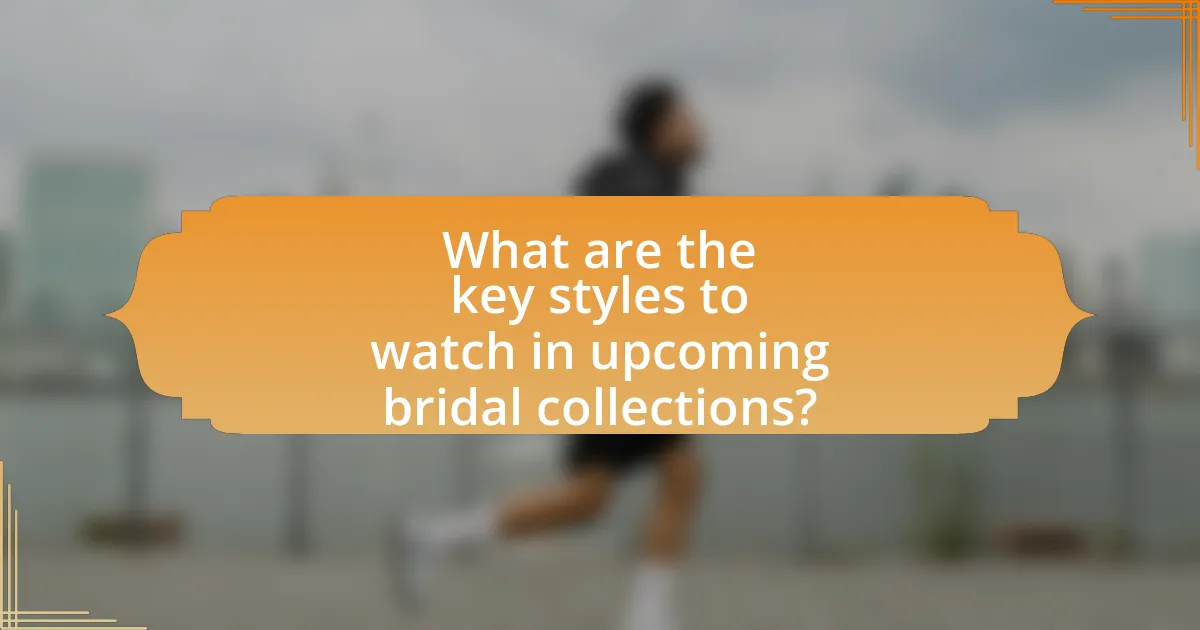
What are the key styles to watch in upcoming bridal collections?
Key styles to watch in upcoming bridal collections include minimalist silhouettes, bold colors, and sustainable fabrics. Minimalist silhouettes emphasize clean lines and simplicity, reflecting a shift towards modern elegance. Bold colors, such as deep reds and vibrant blues, are gaining popularity as brides seek to express individuality. Sustainable fabrics, including organic cotton and recycled materials, are increasingly favored as eco-consciousness rises among consumers. These trends are supported by industry reports indicating a growing demand for unique and environmentally friendly bridal options.
Which silhouettes are gaining popularity among brides?
A-line and ball gown silhouettes are gaining popularity among brides. A-line dresses, characterized by a fitted bodice that gradually flares out from the waist, offer versatility and a flattering shape for various body types. Ball gowns, known for their voluminous skirts and structured bodices, evoke a classic and romantic aesthetic that many brides desire. Recent bridal fashion shows and industry reports indicate a resurgence in these styles, reflecting a preference for timeless elegance combined with modern touches.
What are the characteristics of the most sought-after bridal silhouettes?
The most sought-after bridal silhouettes are characterized by their ability to enhance the bride’s figure while offering a blend of elegance and comfort. Popular silhouettes include the A-line, which flatters various body types with its fitted bodice and flared skirt, and the ball gown, known for its dramatic volume and traditional appeal. The sheath silhouette, which closely follows the body’s natural shape, is favored for its modern and minimalist aesthetic. Additionally, the mermaid silhouette, which hugs the body and flares out at the knees, is sought after for its glamorous and sophisticated look. These silhouettes are often chosen based on current trends that emphasize personalization, sustainability, and versatility in bridal fashion.
How do these silhouettes cater to different body types?
Silhouettes in bridal fashion cater to different body types by offering a variety of shapes that enhance and flatter individual figures. For example, A-line silhouettes are universally flattering, as they cinch at the waist and flow out, accommodating both curvy and slender body types. Ball gowns provide volume and structure, ideal for those seeking a dramatic look, while sheath dresses offer a sleek, form-fitting option that highlights the natural shape of the body. Additionally, empire waistlines create a high waist that elongates the legs, making them suitable for petite figures. These design choices are supported by industry trends that emphasize inclusivity and body positivity, reflecting a growing demand for diverse options in bridal wear.
What color palettes are trending in bridal fashion?
Neutral tones, soft pastels, and rich jewel tones are currently trending in bridal fashion. Neutral palettes, including shades like ivory, beige, and taupe, provide a timeless elegance that appeals to modern brides. Soft pastels, such as blush pink, lavender, and mint green, offer a romantic and whimsical touch, reflecting a desire for a softer aesthetic. Rich jewel tones, including emerald green, sapphire blue, and deep burgundy, are gaining popularity for their boldness and sophistication, allowing brides to make a statement. These trends are supported by recent bridal fashion shows and collections that showcase these color palettes as key elements in contemporary bridal wear.
How are traditional white gowns evolving in color choices?
Traditional white gowns are evolving to include a wider palette of colors, reflecting modern brides’ desire for personalization and individuality. Recent trends show that shades such as blush, champagne, and even bold colors like red and blue are gaining popularity, as brides seek to express their unique styles and cultural backgrounds. According to a survey by The Knot, 25% of brides opted for non-white gowns in 2022, indicating a significant shift in color preferences within bridal fashion. This evolution highlights a broader acceptance of diverse aesthetics in wedding attire, moving away from the conventional all-white tradition.
What seasonal colors are expected to dominate bridal collections?
Seasonal colors expected to dominate bridal collections include soft pastels, earthy tones, and vibrant jewel hues. In recent years, designers have increasingly embraced shades like blush pink, sage green, and deep emerald, reflecting a shift towards more personalized and unique bridal aesthetics. This trend aligns with consumer preferences for individuality and sustainability in fashion, as evidenced by the growing popularity of eco-friendly materials and custom designs in bridal wear.
What accessories are becoming essential for modern brides?
Modern brides are increasingly incorporating statement jewelry, personalized veils, and stylish footwear as essential accessories. Statement jewelry, such as bold earrings or layered necklaces, enhances the bridal look and allows for individual expression. Personalized veils, often featuring custom embroidery or unique embellishments, add a personal touch and reflect the bride’s style. Additionally, stylish footwear, including chic flats or colorful heels, is becoming popular for comfort and fashion, allowing brides to move easily throughout their special day. These trends highlight a shift towards individuality and practicality in bridal fashion.
How are veils and headpieces being reimagined in contemporary bridal fashion?
Veils and headpieces are being reimagined in contemporary bridal fashion through innovative designs, materials, and personalization options. Designers are moving away from traditional styles, opting for unique elements such as floral crowns, statement hairpieces, and minimalist veils that incorporate modern fabrics like tulle and lace with intricate embellishments. This shift reflects a broader trend towards individuality in bridal attire, allowing brides to express their personal style. For instance, the rise of customizable options enables brides to select colors, lengths, and adornments that resonate with their vision, showcasing a departure from conventional norms.
What types of jewelry are trending for brides in the coming years?
Brides in the coming years are trending towards personalized and sustainable jewelry options. Custom pieces that reflect individual stories and styles are gaining popularity, with many brides opting for unique designs that incorporate meaningful symbols or heirloom elements. Additionally, sustainable materials, such as lab-grown diamonds and recycled metals, are increasingly favored as brides seek to align their purchases with eco-conscious values. This shift is supported by a growing consumer demand for ethical sourcing and transparency in the jewelry industry, indicating a significant change in bridal jewelry preferences.

How can brides prepare for the future of bridal fashion?
Brides can prepare for the future of bridal fashion by staying informed about emerging trends and incorporating sustainable practices into their planning. Research indicates that the bridal industry is increasingly leaning towards eco-friendly materials and designs, with a 2021 survey showing that 70% of brides prioritize sustainability in their wedding choices. By following fashion influencers, attending bridal shows, and exploring online platforms, brides can gain insights into innovative styles and designers that reflect future trends. Additionally, considering customizable options allows brides to create unique looks that align with evolving fashion standards.
What tips should brides consider when choosing their bridal attire?
Brides should prioritize comfort and personal style when choosing their bridal attire. Selecting a gown that allows for ease of movement and reflects individual taste ensures a positive experience on the wedding day. Additionally, considering the wedding venue and season is crucial; for instance, lightweight fabrics are ideal for summer outdoor weddings, while heavier materials suit winter ceremonies. Research indicates that 70% of brides prioritize comfort over trends, highlighting the importance of feeling at ease in one’s attire.
How can brides balance personal style with current trends?
Brides can balance personal style with current trends by selecting elements that reflect their individuality while incorporating popular design features. For instance, a bride may choose a classic silhouette that aligns with her personal taste but enhance it with trendy details such as unique fabrics or contemporary embellishments. This approach allows brides to maintain their unique identity while still embracing the evolving landscape of bridal fashion. Research indicates that 70% of brides prioritize personal style over trends, yet 60% also seek to integrate at least one current trend into their wedding attire, demonstrating a clear desire for this balance.
What should brides keep in mind regarding budget and sustainability?
Brides should prioritize a clear budget while considering sustainable options for their wedding. Establishing a budget helps in making informed decisions about eco-friendly choices, such as selecting local vendors, opting for sustainable materials, and reducing waste. For instance, according to a study by the Wedding Report, 30% of couples are now prioritizing sustainability in their wedding planning, which often leads to cost savings through reduced spending on extravagant items. By focusing on budget and sustainability, brides can create a meaningful celebration that aligns with their values and financial constraints.
How can brides stay informed about the latest bridal fashion trends?
Brides can stay informed about the latest bridal fashion trends by following fashion blogs, subscribing to bridal magazines, and engaging with social media platforms dedicated to wedding planning. Fashion blogs often feature the latest collections and designer interviews, while bridal magazines provide in-depth coverage of seasonal trends and expert advice. Social media platforms like Instagram and Pinterest showcase real-time updates from designers and influencers, allowing brides to see current styles and inspirations. According to a survey by The Knot, 80% of brides use social media as a primary source for wedding inspiration, highlighting its effectiveness in keeping brides updated on trends.
What resources are available for brides to explore upcoming trends?
Brides can explore upcoming trends through various resources such as bridal magazines, fashion blogs, social media platforms, and wedding expos. Bridal magazines like “The Knot” and “Brides” regularly feature trend forecasts and style guides, providing insights into the latest designs and themes. Fashion blogs, including “Style Me Pretty” and “Green Wedding Shoes,” offer curated content on contemporary bridal fashion and emerging trends. Social media platforms, particularly Instagram and Pinterest, serve as visual inspiration hubs where brides can follow designers and influencers to stay updated on the latest styles. Additionally, attending wedding expos allows brides to interact with vendors and view trend showcases firsthand, making these events valuable for trend exploration.
How can social media influence a bride’s fashion choices?
Social media significantly influences a bride’s fashion choices by providing a platform for inspiration, trends, and community engagement. Platforms like Instagram and Pinterest showcase a vast array of bridal styles, allowing brides to discover new designers, trends, and ideas that resonate with their personal aesthetics. According to a survey by The Knot, 87% of brides use social media for wedding planning, highlighting its role in shaping their fashion decisions. Additionally, social media enables brides to connect with other brides and industry professionals, fostering a sense of community and access to real-time feedback on fashion choices. This interconnectedness amplifies the impact of visual content, making social media a crucial factor in contemporary bridal fashion.
